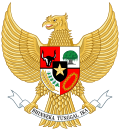Second Amir Sjarifuddin Cabinet Kabinet Amir Sjarifuddin II | |
|---|---|
| 6th Cabinet of Indonesia | |
| 1947–1948 | |
 | |
| Date formed | 11 November 1947 |
| Date dissolved | 29 January 1948 |
| People and organisations | |
| Head of state | Sukarno |
| Head of government | Amir Sjarifuddin |
| No. of ministers | 32 ministers |
| Member party | PS Masyumi PSII PBI PNI Parkindo PKI People's Youth BTI Catholic Independent |
| History | |
| Predecessor | Amir Sjarifuddin I Cabinet |
| Successor | Hatta I Cabinet |
| ||
|---|---|---|
Pre-independence Domestic policy Foreign policy Family Media and legacy | ||
The Second Amir Sjarifuddin Cabinet (Indonesian : Kabinet Amir Sjarifuddin II) was Indonesia's sixth cabinet and was the result of a reshuffle to allow for the entry of the Masyumi Party, which gained five posts. The cabinet lasted only two months and eleven days, from 11 November 1947 to 29 January 1948, after Masyumi withdrew its ministers in protest at the Renville Agreement the government signed with the Dutch.

